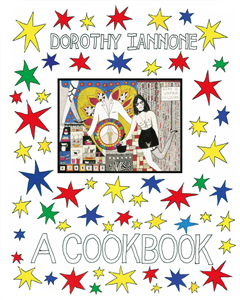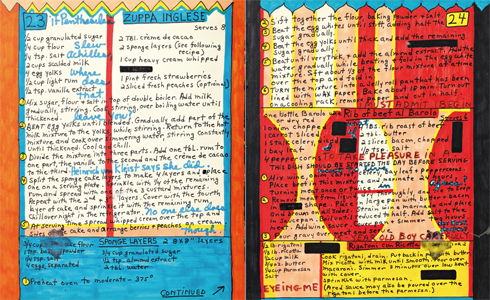Since the 1960s, Dorothy Iannone has attempted to represent ecstatic love, “the union of gender, feeling, and pleasure.” Today her oeuvre, encompassing paintings, drawings, collages, videos, sculptures, objects, and artist's books, is widely recognized as one of the most provocative and fruitful bodies of work in recent decades in terms of the liberalization of female sexuality, and political and
feminist issues. As
Robert Filliou stated already in 1972, “She is a freedom fighter, and a forceful and dedicated artist, skillfully blending imagery and text, beauty and truth. Her aim is no less than human liberation.” A narrative element fed with personal mythologies, experiences, feelings, and relationships runs through all of her work, unified by her distinctive colorful, explicit, and comic book-like style.
Created in 1969, when she was living with Swiss artist
Dieter Roth, the
Cookbook is a perfect example of how she mixes daily life and an existential approach, culminating in her vision of cooking as an outlet for both eroticism and introspection. A real book of recipes full of visual delights, the
Cookbook contains densely decorated pages with patterned designs, packed text, and vibrant colors. Personal sentences are interspersed among the lists of ingredients, revealing the exultations and tribulations of her life between the lines of recipes. Filled with wit and wordplay, associations between aliments and idiosyncratic thoughts—“At least one can turn pain to color” accompanies the recipe for gazpacho; “Dorothy's spirit is like this: green and yellow,” is written next to the ingredients for lentil soup—the
Cookbook constitutes a mundane but essential self-portrait of the artist as a cook and a lover.
This publication is a facsimile of the 1969 original, now published with a dust jacket specially designed by the artist in 2017.
For more than six decades, American artist Dorothy Iannone (1933, Boston–2022, Berlin) attempted to represent ecstatic love, the union of gender, feeling, and pleasure. Today her oeuvre, which encompasses painting, drawing, collage, video, sculpture, objects, and artist's books, is widely recognized as one of the most provocative and fruitful bodies of work in recent decades in terms of the liberalization of female
sexuality, and political and
feminist issues. As
Fluxus artist
Robert Filliou declared as early as in 1972, "She is a freedom fighter, and a forceful and dedicated artist, skillfully blending imagery and text, beauty and truth. Her aim is no less than human liberation." A narrative element fed with personal mythologies, experiences, feelings, and relationships runs through all of her work, unified by her distinctive colorful, explicit, and comic book style.
Active from the 1960s to the early 2020s, her work has been recently exhibited at the Louisiana Museum of Modern Art, Humlebaek (2022); the Centre Pompidou, Paris (2019); the Serpentine Pavilion, London (2018); the Swiss Cultural Center, Paris (2016); MAMCO, Geneva (2017); the Migros Museum für Gegenwartskunt, Zurich, and the Berlinische Galerie, Berlin (2014); the New Museum, New York (2009).
See also
Dieter Roth.


